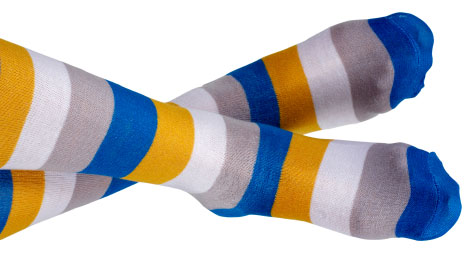Use this step-wise approach to prevent and care for blisters.
How many miles do you march in a parade? The answer might surprise you! Besides the length of the parade route itself, add in walking to and from the venue. The Rose Parade is close to a half marathon. With all that marching comes the inevitable blister, which arises from friction between toes, soles and heels rubbing on socks and shoes with vigorous activity.
Here’s how to cross the finish line with happy feet.
Block Perspiration
Sweat creates swelling of the upper skin layers, so antiperspirant powders or sprays may help cut down on blisters. Look for the ingredient aluminum chlorhydrate or aluminum chloride. Rub a dime-sized patch on the sole of your foot every night for a week to test for allergic reaction.
Start three to five nights before the long march, applying to dry, clean feet. The antiperspirant gradually plugs the sweat pores with each use. If using powder, sprinkle between toes, then inside socks and shoes.
Lubricate
Lubrication prevents friction, so use petroleum jelly or nonpetroleum lubricants before marching. If a hot spot develops, lube it up!
Choose the Right Socks
Cotton socks retain sweat. Moisturewicking material is best with polypropylene, acrylic or polyester socks. A thin “liner sock” combined with a heavier polyester sock is great for cold weather and long marches. If seams stick up across the toe, wear the sock inside out, so the seam doesn’t rub. After a vigorous practice, let your feet air out and change to a fresh pair of socks before the performance. This is also a good time to quickly check your feet. If you have any red sore spots—the first sign of a blister—take care of them right away.
Break in Shoes
Never march in new shoes. Try on shoes with socks and any inserts— such as insoles or orthotics—that you will wear while marching.
Break in shoes gradually. Check them for abnormal wear, especially for seams coming apart or holes inside seams, tongues and backs of heels. Worn areas can rub against feet and make blisters.
Be Prepared
Assemble a medical kit with alcohol wipes, petroleum jelly, blister bandages and fresh socks. For sore spots, lubricate with petroleum jelly. Apply protective bandage or blister dressings. Seek medical attention right away if there is increasing pain, pus in the blister or red streaks coming out of blister and spreading onto your foot as these may be signs of infection or deeper injury.
Take care of your feet, and they will take you far. Happy marching!
About the Author
Susan Boiko, M.D., is a dermatologist with Kaiser Permanente specializing in skin problems of children and teenagers. She is also a former Girl Scout Fife and Drum Corps member in Bellerose, N.Y., and a past music boosters president at San Marcos (Calif.) High School. She is the mother of three musicians: Becky at Arizona State University; Laura, drum major and band president at San Marcos High School; and twin sister, Shayna, marching mellophone section leader and budding composer. All three play French horn.


